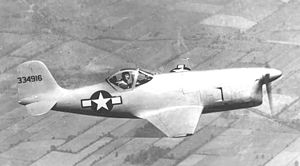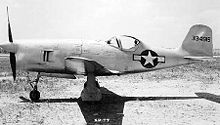Bell XP-77 Video - Historical overview
|
|

Role: Fighter aircraft
Manufacturer: Bell Aircraft Corporation
First flight: 1 April 1944
Retired: December 1944
Primary user: U.S. Army Air Force
Number built: 2 prototypes
The Bell XP-77 development was initiated by the United States Army Air Corps during World War II to produce a simplified 'lightweight' fighter aircraft using so-called "non-strategic" materials. Despite being innovative, the diminutive prototype proved tricky to handle and the project was canceled when the XP-77 did not deliver its projected performance.
Design and development
The project with the Bell Aircraft Corporation was initiated in October 1941. Originally a design study for the P-39, the XP-77 was intended to be a small, light fighter much in the mold of the 1930s air racers. The aircraft featured a single-engine, low-wing monoplane with mainly wood construction, equipped with tricycle landing gear, a Bell trademark that bestowed good ground handling. A sleek bubble canopy also provided great visibility in all directions except forward (a key requirement for a fighter).
While originally conceived using an air-cooled 500 hp Ranger XV-770-9 12-cylinder engine with a supercharger, the prototypes were delivered with the unsupercharged XV-770-7 engine due to engine development delays. The planned armament was one Hispano 20 mm cannon and two 0.5 inch Browning machine guns, with the option of either a 300 lb bomb or 325 lb depth charge.
Testing
The project suffered numerous delays, many for correction of excess weight issues. The first XP-77 flew 1 April 1944 at Wright Field. These trials revealed vibration problems due to directly mounting the engine to the airframe, without vibration isolation. The long nose and rear-mounted cockpit inhibited visibility relative to operational aircraft of the time.
The XP-77 proved to be difficult to fly and despite flying without guns or armor, it did not come up to the expected performance estimates mainly because it was woefully underpowered. Further trials were conducted at the A.A.F. Proving Ground at Eglin Field with the second aircraft, which was destroyed when it entered an inverted spin while attempting an Immelmann, and the pilot bailed out. The development was terminated in December 1944.
Specifications (Bell XP-77)

Picture - Bell XP-77 side view.
Data from Jane's Fighting Aircraft of World War II and
General characteristics
Crew: 1 pilot
Length: 22 ft 10 in (6.96 m)
Wingspan: 27 ft 6 in (8.38 m)
Height: 8 ft 2 in (2.49 m)
Wing area: 100 sqâft (9.3 m²)
Empty weight: 2,855 lb (1,295 kg)
Max takeoff weight: 4,028 lb (1,827 kg)
Powerplant: 1x Ranger V-770-7 inverted V12 engine, 520 hp (388 kW)
Performance
Maximum speed: 330 mph (290 knots, 530 km/h)
Range: 550 mi (480 nmi, 890 km)
Service ceiling: 30,100 ft (9,180 m)
Rate of climb: 3,600 ft/min (1,097 m/min)
Wing loading: 40.28 lb/sqâft (196.5 kg/m²)
Power/mass: .13 hp/lb (.21 W/kg)
Armament
Guns:
1x 20 mm (0.787 in) Hispano-Suiza HS.404 cannon, firing through the spinner
2x .50 in (12.7 mm) M2 machine guns with 200 rounds each.
Bombs:
1x 300 lb (136 kg) bomb or
1x 325 lb (147 kg) depth charge
Comparable aircraft
Caudron C.714
Douglas XP-48
Miles M.20
Tucker XP-57
VEF I-16
Zlin Z-XIII
Bibliography
Bridgeman, Leonard, ed. "The Bell XP-77." Janeâs Fighting Aircraft of World War II. London: Studio, 1946. ISBN 1-85170-493-0.
Green, William. War Planes of the Second World War, Volume Four: Fighters. London: MacDonald & Co. (Publishers) Ltd., 1961 (Sixth impression 1969). ISBN 0-356-01448-7.
Green, William and Gordon Swanborough. WW2 Aircraft Fact Files: US Army Air Force Fighters, Part 1. London: Macdonald and Jane's Publishers Ltd., 1977, pp. 25-26. ISBN 0-356-08218-0.
O'Leary, Michael. USAAF Fighters of World War Two. Harrisburg, PA: Harrisburg Historical Times, 1986. ISBN 0-7137183-9-0.
Winchester, Jim. The World's Worst Aircraft: From Pioneering Failures to Multimillion Dollar Disasters. London: Amber Books Ltd., 2005. ISBN 1-904687-34-2.
Living Warbirds: The best warbirds DVD series.
Source: WikiPedia